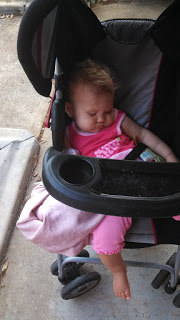My first daughter was an amazing sleeper, from the newborn stage and still is today at her present age of four. I truly believe I took this blessing for granted though, as I knew no different. When other moms would talk about the sleeping issues with their little ones, or parents would complain about poor rest on Facebook, I was not too sympathetic. I wasn’t judgmental — but I had no reference point. My kid slept well. That was all I knew.
Then along came Erinn. Oh my. This kid hates sleep. I blame it on my husband, of course, who is an admittedly poor sleeper. The biggest adjustment I had to make when we got married was him falling asleep with ear buds in, listening to podcasts to “distract” him from the idea of falling asleep. Sleep freaks him out. He doesn’t like it. And neither does his youngest.
I knew the first few months would be rough with a newborn sleep pattern, but when Erinn had made no progress at night and was refusing naps at nearly six months old, I realized she needed some coaxing. Read: I needed sleep and was desperate for a way to find it. I had heard about Elizabeth Pantley’s book The No-Cry Sleep Solution and it had been on my list of things to read for, well, six months. I bought it on my e-reader and started reading it in small doses while nursing.
The first thing you should know about this book and method is that there is no specific formula. Yes, there are tips and suggestions and first-person accounts of what worked for particular families. But if you are looking for something regimented that gives you specific steps to sleep-filled bliss, this book will not do that for you.
In fact, when I first read it in a tired, exhausted haze I felt discouraged. I read ahead and skimmed through the pages looking for answers. I wanted to know how long it would take for my baby to start sleeping through the night and napping twice per day. Strike that. I wanted to know when my baby would start sleeping for any stretch longer than three hours at a time.
 |
| Sleep is for the weak |
She hated bottles even more than she hated sleep, which meant that at the time I started to read Pantley’s book, I too had not slept for longer than three hours at a time for nearly seven months. I was a hot mess looking for an intervention. There were no magical answers in the book — no super tricks that would make these dreams come true for me. Just suggestions and guidance.
That being said, the book intrigued me. The first chapter was all about the science of baby sleep patterns. Pantley references the “normal” waking times for babies based on the sleep cycle and wouldn’t you know it? Erinn’s wake ups at night lined up with each one. I learned quickly that Erinn was not unusual after all; she was a normal, healthy baby that needed some extra guidance settling on her own when her body woke up naturally. This information was both helpful and annoying. Somehow I was supposed to battle nature and come out on top. But as I glanced at the bags under my eyes and my interesting hair style du jour, I decided it was something I needed to do for my baby — but most importantly, for myself.
Challenge accepted, nature.
As I mentioned earlier, the book is not about a step-by-step sleep program, per se. It is more about suggestions that may or may not work for every family and situation. For those that are intrigued, please buy the book. It says things about baby-parent relationships and sleep in general that I have NEVER read or heard anywhere else.
 |
| Stroller rides don’t count, Mom |
I learned a lot while reading this book and I am still constantly going back to re-read parts that didn’t seem relevant before but make sense now. Erinn is still not sleeping completely serenely every night, or napping for consistent lengths, but I am sleeping for MUCH longer than three hours at a time. With consistency, I believe the sleep practices I am implementing will lead to healthy sleep habits for her in the long term, so I’m okay with a gradual arrival at permanent solutions.
If you have heard about this book or these methods and want to give them a try, here are the suggestions that worked for our family:
1. Improve naps first. The idea that less sleep during the day will lead to a better night’s sleep is flawed — at least when it comes to babies. Little ones that get regular naps during the day WILL sleep longer and more soundly during the nighttime hours. Before reading this book, I tried a regimented nap schedule (didn’t work) and also tried paying attention to her tired cues and basing naps on that instead (failed miserably).
The problem with a baby that doesn’t sleep well is that he or she will ALWAYS appear tired, because he or she likely is always tired. Add my own exhaustion and caring for three other kids on top of that — and remaining vigilant to sleep cues was not a battle I was ever going to win. So I monitored her daylight sleep cues for several days and developed an outline for nap times based on that. She is now taking two naps every day, ranging from 45 minutes to 2.5 hours each. With these two naps in place, she is also ready for bed by 6 p.m. every night, generally waking once at 3 a.m. then sleeping until 6:30 a.m. Naps work.
2. Put baby in crib during waking hours. Ever heard the parenting tidbit about NEVER putting a baby in a crib unless it is sleep time? Yeah, me too. The theory is that a baby only placed in a crib for sleep will understand that the spot is reserved for rest, and not play time. It makes sense and actually worked perfectly for my oldest daughter when she was a baby and toddler.
For a baby like Erinn who detests sleep and is in many ways terrified of it, a crib is a scary place. In order to break her automatic habit of wailing at the top of her lungs the moment her diapered tush touched the crib mattress, we started putting her in it random times during the day. I started to set her in there with toys while I put away laundry in the room. She sat in there and watched her older siblings play Mario Kart on the Wii for 15 to 20 minutes at a time (while I ate lunch alone down the hallway). She started to wake from naps and in the morning and roll around happily for a few minutes before letting out a few squawks of complaint. Soon she was allowing us to set her down awake and leave the room at nap times.There are still times she screams like the crib is swallowing her whole, but for the most part, she likes being in there and is able to be set in it awake and then fall asleep.
3. Recognize “sleep” crying. Those first few weeks after a baby comes home are a blur, especially at nighttime. When a baby cries in the middle of the night, she must be attended to and promptly. Ideally, the baby starts crying less at night until a parent can declare that she is “sleeping through the night.” When your baby is still waking up crying at four, five, six months and beyond, you have to rethink your waking-up-at-every-cry plan.
Pantley points out that some babies cry in their sleep, or fuss slightly when awoken, but are not really in distress. To pick up a crying child who is actually sleeping can awaken her even more. This common sense point made me reevaluate my reaction to Erinn’s nighttime crying. In a sleepy haze, it is often easier to just scoop her up and feed her but I took a step back and tried to start really focusing in on whether she actually needed me during her night wakings, or not wakings. I still wander over to her crib like a zombie and pick her up, pretty much asleep myself, when I hear her cry sometimes but most times I am letting her resettle on her own without intervention.
4. Provide serenity LONG before rest time. A child that is the fourth of four relatively young kids is around a lot of stimulation during her waking hours. Though I had established the habit of a bedtime nursing in a dark, sound-machine filled room, she was still fidgety and restless when the time for sleep arrived. The same was true of nap time. What I realized in reading other stories in this book is that counting on a mere 10 to 15 minutes for an over-stimulated baby to settle before bed is simply not enough.
Pantley asks readers to keep a log of what the baby does in the time leading up to bed or a nap, including the noise level and amount of brightness in the room. When I wrote down the pre-bed routine in the hour leading up to her prescribed rest periods, I discovered that poor little Erinn was in sensory overload. I started to think of bedtime as a window of several hours, instead of the half hour leading up to the point when I wanted her to be asleep. I came to this realization in early December — just in time for our traditional walks after dinner to look at the Christmas lights in our neighborhood. This calming activity provided a great transition from the hustle and bustle of dinnertime to the quiet, calm needed for bedtime.
Not every night is smooth sailing, of course and her morning nap comes so quickly after shuttling the two oldest off to school that quiet/non-chaotic mode is nearly impossible. Still, I now understand the why of the restlessness and am always mindful of how her immediate surroundings affect her ability to fall asleep peacefully — and the ways to stack the serenity in our favor. I know there are other suggestions out there too – like the support of weighted blankets or diffusing certain oils. Essentially, you just have to go with what works for your child, your family, your routine.
If it has been months and you are still waiting patiently for your baby to fall asleep on her own, nap routinely or sleep through the night, you could be waiting for a long time. Yes, your baby will eventually get there but it could take many more months, if not years. While I actually have no qualms about the cry it out, or Ferber, method, I felt it was not right for Erinn. For those people that think the only two options are to let a baby cry or to just deal with exhaustion, I’d highly recommend taking a look at this book too. Be open to changing your own habits, however, to really make the most of Pantley’s suggestions.
Let’s connect on social media too:
Mumbling Mommy on Facebook
Mumbling Mommy on Twitter
Mumbling Mommy on Pinterest
Category: BabiesTags: books









